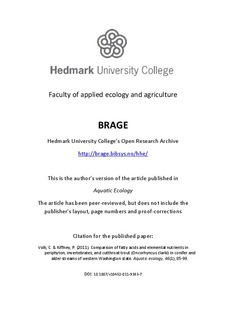| dc.identifier.citation | Volk, C. & Kiffney, P. (2011). Comparison of fatty acids and elemental nutrients in periphyton, invertebrates, and cutthroat trout (Oncorhyncus clarki) in conifer and alder streams of western Washington state. Aquatic ecology, 46(1), 85-99. | no_NO |
| dc.description.abstract | Organism growth and reproduction are often limited by nutrient availability in freshwater ecosystems where, in some cases, food webs are primarily supported by allochthonous organic matter. Therefore, we hypothesized that the composition of riparian vegetation would influence the variability of N, P and fatty acid content of in-stream consumers. Specifically, we predicted that organisms living in alder streams would have higher levels of N, P, and polyunsaturated fatty acids than organisms in coniferous streams. To determine this, we sampled fresh and aged leaf litter, periphyton, invertebrates, and cutthroat trout (Oncorhynchus clarki) from 6 streams in western Washington state: 3 streams had high densities of nitrogen-fixing red alder (Alnus rubra) in the riparian zone, whereas 3 had high densities of conifers. We found fresh alder litter had twice the total polyunsaturated fatty acid concentrations of hemlock vegetation while there were few statistical differences among aged alder and aged hemlock vegetation. Multidimensional plots showed fatty acid profiles were unique to vegetation and fish while periphyton and invertebrates shared the same multidimensional space. We used a mixed model to determine the relative importance of vegetation type (fixed factor: conifer or alder), trophic levels (fixed factor: periphyton, primary consumer, or fish) and streams (random factor) on individual fatty acid concentrations. Total polyunsaturated fatty acids, 16:0, 20:1, 20:3n6 and total n3 were the only fatty acids influenced by stream vegetation (vegetation + stream model or full model. 67% of the fatty acids were best supported by the trophic +stream model. Nitrogen, P, Ca, Fe, C:N, N:P and C:N:P were all best supported by the trophic level + stream model and Zn was the only nutrient supported best by the full model. Correlations of n3 and n6 fatty acid concentrations between periphyton and primary consumers, and primary consumers with trout indicated several fatty acid metrics, such as n3:n6, showed food resources may affect relative fatty acid abundances of consumers. Although vegetation type did not influence relative fatty acids of stream organisms, the importance of trophic level likely indicates organisms have different physical requirements for fatty acids. The significance of a random factor, ‘stream,’ suggests that the relative abundances of fatty acids in periphyton, invertebrates and trout are more related than similar organisms from another stream. | no_NO |
